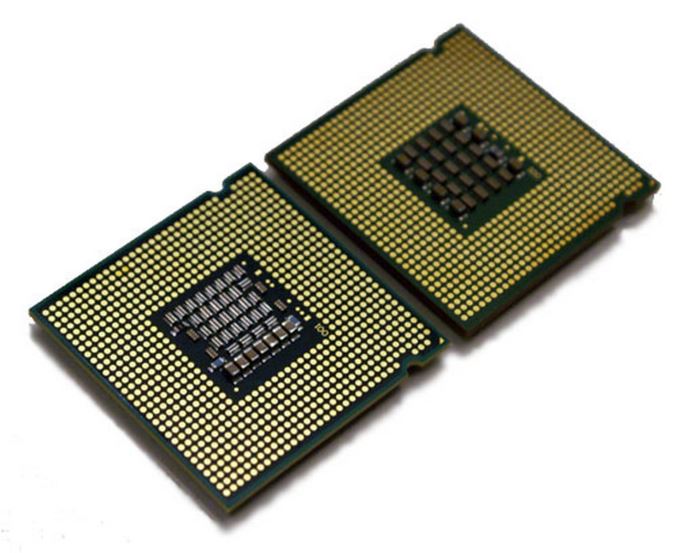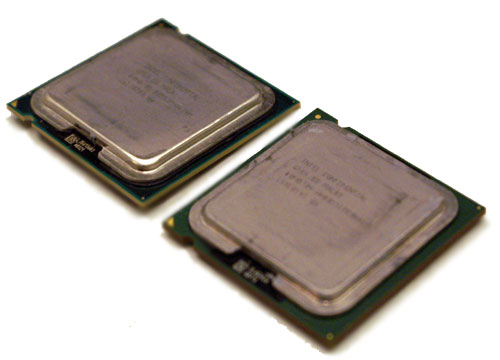Ten Year Anniversary of Core 2 Duo and Conroe: Moore’s Law is Dead, Long Live Moore’s Law
by Ian Cutress on July 27, 2016 10:30 AM EST- Posted in
- CPUs
- Intel
- Core 2 Duo
- Conroe
- ITRS
- Nostalgia
- Time To Upgrade

Today marks a full 10 years since the first Core 2 Duo processors, and hence Intel’s 64-bit Core microarchitecture, were made officially available at retail. These included a number of popular dual-core processor parts, including the seemingly ubiquitous E6400 and the Core 2 Extreme X6800. These were built on Intel’s 65nm process, and marked a turning point in the desktop processor ecosystem. To quote Anand in our launch review: ‘you’re looking at the most impressive piece of silicon the world has ever seen’.
Ten Year Anniversary of Core 2 Duo and Conroe
As part of this piece we will also look at some of the predictions for the future, from the latest (and possibly last) International Technology Roadmap for Semiconductors report, which predicts the stalling of smaller silicon manufacturing nodes over the next 10-15 years.
The first part of this article borrows heavily from Johan’s original look into the Intel Core microarchitecture back in 2006. It’s an awesome read.
Back When I Were A Lad
For a number of our readers, the launch of Conroe was a vast change in the processing landscape. The family of Netburst, Northwood and Prescott processors, in the form of Pentium D and Pentium 4, showed that pursuing the frequency race pushed the silicon far outside its efficiency zone and left a hot, power hungry mess in its wake. It didn’t even come with a muscular V8 sound, and AMD’s Athlon 64 X2 line had taken both the performance and efficiency crown.

Core 2 Duo (left) vs Pentium D (right)
From the perspective of Intel, it had to incorporate a significant paradigm shift in the way it approached the core microarchitecture – no more long pipelines to bump up clock rates to start. The Core microarchitecture design was marketed as a blend of Pentium Pro and Pentium M techniques, as well as the Netburst architecture, however as Johan pointed out at the time, it is significantly Pentium M and it is very hard to find anything Netburst in there. It wasn’t as simple as ‘adding a few functional units or decoders on Yonah and calling it a day’, almost 80% of the architecture and circuit design had to be redone.
As part of this piece, we’re going to take another look at the original architecture improvements of the Core microarchitecture design and some of our old performance metrics from a decade ago.
27th July 2006: Core 2 Launch Day
Ten years ago, Intel launched the following five processors:
| CPU | Clock Speed | L2 Cache |
| Intel Core 2 Extreme X6800 | 2.93GHz | 4MB |
| Intel Core 2 Duo E6700 | 2.66GHz | 4MB |
| Intel Core 2 Duo E6600 | 2.40GHz | 4MB |
| Intel Core 2 Duo E6400 | 2.13GHz | 2MB |
| Intel Core 2 Duo E6300 | 1.86GHz | 2MB |
The X6800 sits at the top with a higher clock speed with a higher supported FSB-to-core ration than previous Intel processors. The Core 2 processors all came from a 143mm2 die, compared the 162mm2 of Pentium D, and they both seem tiny by comparison to the large die sizes we see 2016 for things like the P100. These were chips without integrated graphics either. The introduction of Core 2 pushed the prices of the Pentium D processors down, to give this interesting table:
| CPU | Clock Speed | L2 Cache | Price |
| Intel Core 2 Extreme X6800 | 2.93GHz | 4MB | $999 |
| Intel Core 2 Duo E6700 | 2.66GHz | 4MB | $530 |
| Intel Core 2 Duo E6600 | 2.40GHz | 4MB | $316 |
| Intel Core 2 Duo E6400 | 2.13GHz | 2MB | $224 |
| Intel Core 2 Duo E6300 | 1.86GHz | 2MB | $183 |
| Intel Pentium D 945 | 3.40GHz | 2MBx2 | $163 |
| Intel Pentium D 915 | 2.80GHz | 2MBx2 | $133 |
| Intel Pentium D 820 | 2.80GHz | 1MBx2 | $113 |
| Intel Pentium D 805 | 2.66GHz | 1MBx2 | $93 |
Comparing this to recent Intel processors, and the X8600 matches the list price of the Core i7-5960X (an 8-core part), whereas the popular Core 2 Duo E6400 at $224 at the same price as the Core i5-6600.
A few years ago, I salvaged a super old computer of mine with an E6400 and took it for a spin for a pipeline piece entitled ‘Dragging Core 2 Duo into 2013’. We know that a number of users today are still using the old platform as their day to day machine, and given that it is now celebrating its 10th birthday, it is interesting that anyone wanting to play around with the old hardware can get a motherboard, memory and CPU from eBay for $50-70.
My crusty C2D Setup from 2013











158 Comments
View All Comments
Namisecond - Thursday, July 28, 2016 - link
NVMe may not be all it's cracked up to be. It, for the most part, limits you to booting windows 8 and higher, and good luck with the free upgrade to windows 10 (which supposedly ends tomorrow).FourEyedGeek - Monday, August 8, 2016 - link
Same CPU here, mine is running at 4Ghz, I can't see a reason other than NVMe to upgrade.dotwayne - Thursday, July 28, 2016 - link
Had a trusty E6300 @ 3.4-5 ghz back then. ahhh...miss those days of oc-ing the shit out of these cheap but super capable silicons.jamyryals - Thursday, July 28, 2016 - link
Neat article, I enjoyed it Ian!azazel1024 - Thursday, July 28, 2016 - link
Yeah a lot of those assumptions and guestimates for the future seem either overly optimistic or seem to ignore realities. I realize board power doesn't equate to average power use, but you are still talking about max power consumption that would drain a current cell phone battery dead in less than an hour, even on some of the biggest phone batteries.Beyond that is the heat dissipation, that phone is going to get mighty hot trying to dissipate 8+ watts out of even a large phone chassis.
As pointed out, 32 cores seems a wee excessive. A lot of it seems to be "if we take it to the logical extreme" as opposed to "what we think is likely".
Peichen - Thursday, July 28, 2016 - link
Take a 45nm C2Q Q9650 ($50 eBay), overclock to 4.0GHz, and you will be as fast as AMD's FX-9590 that's running at 220W. Older motherboard and DDR2 will be harder to come by but it is sad how AMD never managed to catch up to Core 2 after all these years. E6400 was my first Intel after switching to AMD after the original Pentium and I have never look back at AMD again.Panoramix0903 - Thursday, July 28, 2016 - link
I have made an upgrade from C2D 6550 to Q9650 in my old DELL Optiplex 755 MT. Plus 4x 2GB DDR2 800 MHz, Intel 535 SSD 240 GB, Sapphire Radeon HD7750 1GB DDR5, Sound Blaster X-FI, and USB 3.0 PCI-E card. Running Windows 7 Professional. 3-times more power then original DELL configuration :-)JohnRO - Thursday, July 28, 2016 - link
I just logged in to tell you that I'm reading this article on my desktop PC which has a Intel Core 2 Duo E4300 processor (1,8 GHz, 200 MHz FSB) with 4 GB of RAM (started with 2). When I wanted (or needed) I overclocked this processor to 3 GHz (333 MHz FSB).My PC will have its 10 years anniversary this December. During the years I upgraded the video card (for 1080p h264 hardware decoding and games when I still played them) and added more hard drives. The PC has enough performance for what I’m using it right now – so I would say that this is a good processor.
siriq - Thursday, July 28, 2016 - link
I still got my mobile 2600+ barton @2750 mhz , 939 3800+ x2 @2950 mhz . They were awesome!althaz - Thursday, July 28, 2016 - link
I bought a C2D E6300 the week it came out, my first Intel CPU since 2000. My previous CPUs had been an AMD Athlon 64 and an AMD Athlon Thunderbird.That E6300 remains my all-time favourite CPU. It's still running in a friend of mine's PC (@ 2.77Ghz, which I overclocked it to soon after getting it). It was just *so* fast compared to my old PC. Everything just instantly got faster (and I hadn't even upgraded my GPU!).